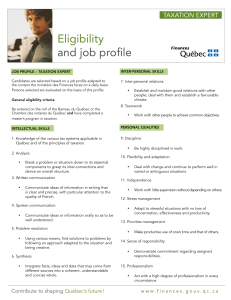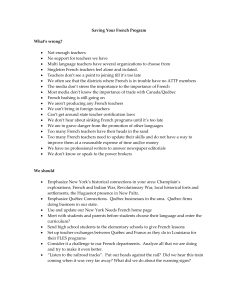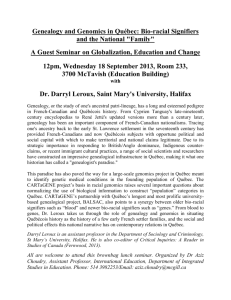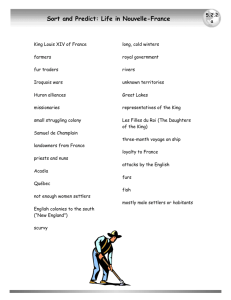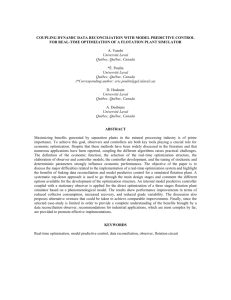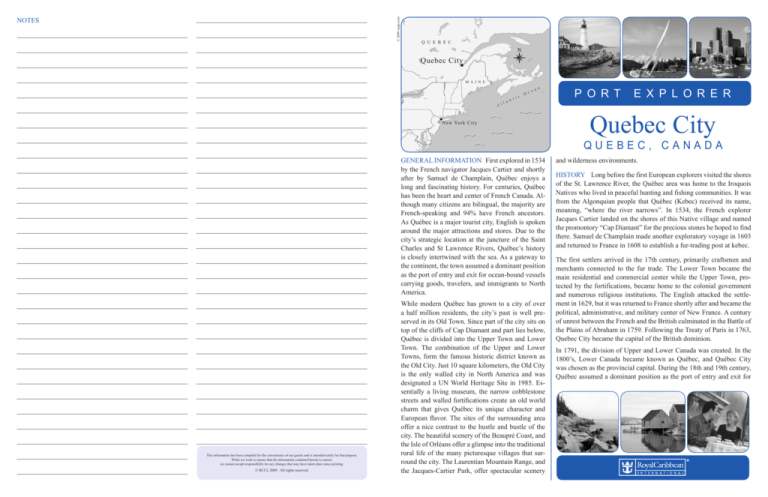
© 2009 maps.com
NOTES
Q U E B E C
Quebec City
M A I N E
i c
n t
l a
A t
n
e a
O c
N e w Yo r k C i ty
P O R T
E X P L O R E R
Quebec City
QUEBEC, CANADA
GENERAL INFORMATION First explored in 1534
by the French navigator Jacques Cartier and shortly
after by Samuel de Champlain, Québec enjoys a
long and fascinating history. For centuries, Québec
has been the heart and center of French Canada. Although many citizens are bilingual, the majority are
French-speaking and 94% have French ancestors.
As Québec is a major tourist city, English is spoken
around the major attractions and stores. Due to the
city’s strategic location at the juncture of the Saint
Charles and St Lawrence Rivers, Québec’s history
is closely intertwined with the sea. As a gateway to
the continent, the town assumed a dominant position
as the port of entry and exit for ocean-bound vessels
carrying goods, travelers, and immigrants to North
America.
This information has been compiled for the convenience of our guests and is intended solely for that purpose.
While we work to ensure that the information contained herein is correct,
we cannot accept responsibility for any changes that may have taken place since printing.
© RCCL 2009. All rights reserved.
While modern Québec has grown to a city of over
a half million residents, the city’s past is well preserved in its Old Town. Since part of the city sits on
top of the cliffs of Cap Diamant and part lies below,
Québec is divided into the Upper Town and Lower
Town. The combination of the Upper and Lower
Towns, form the famous historic district known as
the Old City. Just 10 square kilometers, the Old City
is the only walled city in North America and was
designated a UN World Heritage Site in 1985. Essentially a living museum, the narrow cobblestone
streets and walled fortifications create an old world
charm that gives Québec its unique character and
European flavor. The sites of the surrounding area
offer a nice contrast to the hustle and bustle of the
city. The beautiful scenery of the Beaupré Coast, and
the Isle of Orléans offer a glimpse into the traditional
rural life of the many picturesque villages that surround the city. The Laurentian Mountain Range, and
the Jacques-Cartier Park, offer spectacular scenery
and wilderness environments.
HISTORY Long before the first European explorers visited the shores
of the St. Lawrence River, the Québec area was home to the Iroquois
Natives who lived in peaceful hunting and fishing communities. It was
from the Algonquian people that Québec (Kebec) received its name,
meaning, “where the river narrows”. In 1534, the French explorer
Jacques Cartier landed on the shores of this Native village and named
the promontory “Cap Diamant” for the precious stones he hoped to find
there. Samuel de Champlain made another exploratory voyage in 1603
and returned to France in 1608 to establish a fur-trading post at kebec.
The first settlers arrived in the 17th century, primarily craftsmen and
merchants connected to the fur trade. The Lower Town became the
main residential and commercial center while the Upper Town, protected by the fortifications, became home to the colonial government
and numerous religious institutions. The English attacked the settlement in 1629, but it was returned to France shortly after and became the
political, administrative, and military center of New France. A century
of unrest between the French and the British culminated in the Battle of
the Plains of Abraham in 1759. Following the Treaty of Paris in 1763,
Quebec City became the capital of the British dominion.
In 1791, the division of Upper and Lower Canada was created. In the
1800’s, Lower Canada became known as Québec, and Québec City
was chosen as the provincial capital. During the 18th and 19th century,
Québec assumed a dominant position as the port of entry and exit for
ocean-bound vessels. A major shipbuilding industry grew and
the economy flourished as the Old Port became the transit point
for trade of raw materials needed by Britain. With the decline
in the importance of lumber, the growth of the railroad companies, and the technological development of ocean going vessels,
Montreal soon became the center of trade, finance, and industry.
Today, most jobs in Québec are related to public administration,
defense and the service sector.
QUEBEC CITY PLACES OF INTEREST
on the site of the museum, the longboat is the oldest vessel of
its kind found on the American continent The museum also contains seven temporary and international exhibits reflecting human adventures and experiences.
5
Basilique-cathedrale Notre-Dame-de-Québec is the oldest basilica on the North American Continent. The interior
is richly decorated with stained-glass windows, assorted works
of art, and a majestic organ. Buried in the crypt are a number of
Québec’s bishops and governors of New France.
3
The Citadel was built from 1820 to 1850 and contains over
25 buildings including the governor-general’s residence,
the officer’s mess, a military prison, and five heavily fortified
bastions. Military tradition is maintained by the “Beating of Retreat” and the “Changing of the Guard”.
Place Royale is the site of the first permanent settlement of
New France. Its narrow streets, buildings and architecture
testify to four centuries of history. There is an interpretation center and information center in the square.
Quartier du Petit-Champlain dating back to 1608, was
once a small port village and busy trading post with a number of elegant residences. The Quartier has been beautifully
restored and is enjoyed today as a pedestrian – only shopping
street lined with boutiques, art galleries, and cafes.
4
Musée de la Civilisation displays 2 permanent exhibits including “Memoirs, a history of Québec”, and “Objects of
Civilization”, which features the 250 year old longboat. Found
trian only artisan street where local artists display their work.
Stores are generally open from 9:00 am – 6:00 pm. Other streets
with a number of shops include Saint Louis Street, Cartier Street,
and Saint Jean. Place Laurier, located on the outskirts of the city,
is the largest shopping mall in Eastern Canada.
Hotel du Parlement houses Québec’s legislature,
known as the National Assembly. The imposing structure was inspired by 16th century French classicism.
LOCAL CURRENCY The unit of currency in Canada is the
Canadian dollar. While most retail centers and site seeing venues accept U.S. dollars, the exchange rate will be high and your
change will be given in Canadian dollars. It is advisable to exchange currency at banks or exchange bureaus which are located throughout the city.
10
Beyond Québec
6
1
2
Cháteau Frontenac is a world-renowned hotel and landmark of Québec. Named after the Count of Frontenac, the
building was inaugurated in 1893 and completed in 1925 with
the addition of the central tower.
Vieux Port (Old Port) contains a market and an interpretation center that displays an exhibit on the shipbuilding and
lumber industries of the 18th and 19th centuries.
has been converted into a beautiful 250-acre park with hills, gardens, monuments, and an excellent panoramic view from the
cliff overlooking the Old City and Lower Town. In the center of
the park is the National Battlefields Park Interpretation Center
which ishoused in the Museé du Québec.
ÎIe d’Orléans, located just 15 minutes from Québec is a small
island positioned in the center of the St Lawrence River. It is
most noted for its picturesque villages and pastoral farmlands,
which offer a glimpse into the traditional rural life of Québec.
7
8
Dufferin Terrace is a beautiful promenade, which offers
magnificent views of the St. Lawrence River and the surrounding area.
St-Anne-de-Beaupré is the site of the famous basilica built in
honor of the patron saint of Québec, St Anne. Legend has it
that St. Anne, the mother of the Virgin Mary, saved shipwrecked
sailors off Cap Tourmente after they prayed to her. The original
wooden chapel dedicated to the saint was built in 1658. With
over a million and a half visitors a year, the site remains an important religious pilgrimage center.
9
SHORE EXCURSIONS To make the most of your visit to Quebec City and surrounding areas we suggest you take one of our
organized Shore Excursions. For information concerning tour
content and pricing consult your Shore Excursion Brochure or
contact the Shore Excursion Desk. When going ashore, please
be advised to take only necessary items and to secure any valuables onboard.
Parc des Champs-de-Bataille (Plains of Abraham) is the
site of the battle between the French and British armies
which eventually sealed the fate of the French colony. The area
LOCAL CUSTOMS Bargaining: Most shops have set prices.
Bargaining is not a practice in Québec.
Tipping: A 15% tip in restaurants and taxis is customary.
1
4
5
10
6
2
7
9
Local Cuisine: Québec City has more gourmet restaurants per
capita than any other city on the continent. Québecois cuisine
is served in 18th century residences, French gourmet specialties are found in elegant dining rooms, and European bistros
are found throughout the cobblestone streets of the Old City.
The local cuisine is often determined by the season. Springtime
produces a number of maple products. Lobster season and the
hunting season bring local delicacies of exceptional quality.
3
Drink Specialties: With the influence of the French cuisine, you
will find a variety of excellent wines at most restaurants.
8
© 2009 maps.com
SHOPPING FACILITIES Quartier Petit Champlain, the oldest commercial street in North America, is a pedestrian-only
shopping street which offers a variety of local craft stores, boutiques, and art galleries. There is an antique shopping district
located on Rue Saint Paul, northwest of the Place Royale. A
Farmers’Market is located along the waterfront on Rue Saint
André near the Gare du Palais train and bus station.Open hours
are from early morning until mid day. Treasure street is a pedes-
POST OFFICE AND TELEPHONE FACILITIES The Post Office is located at 3 Buade Street near Place d’Armes.
There are a few public telephones available near the port that
accept local coins. Dial the following access numbers to use a
personal calling card:
AT&T: 1.800.225.5288
MCI: 1.800.888.8000
TOURIST INFORMATION There is a Tourist Information Office is located at 12 Ste. Anne Street, across from the Chateau
Frontenac in Place d’Armes.
TRANSPORTATION Local taxis will be available on the pier.
It is recommended that a price is agreed upon with the taxi driver before leaving the pier.

